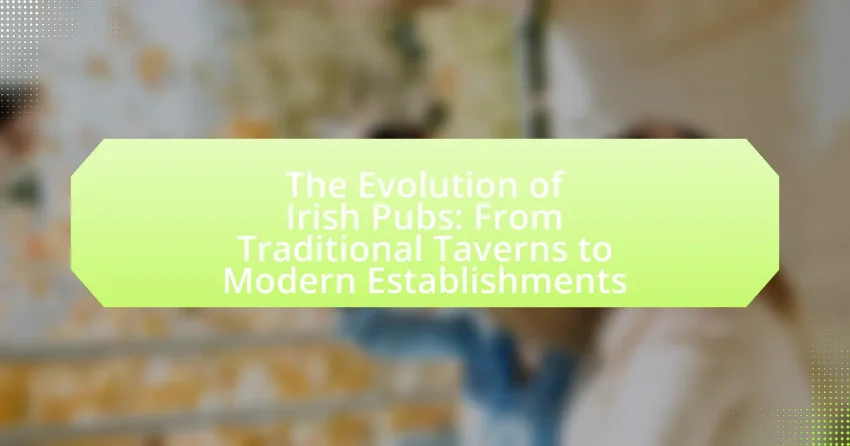The article examines the evolution of Irish pubs, tracing their origins from early 12th-century taverns that served as social gathering places to modern establishments that cater to diverse clientele. It highlights the role of traditional taverns in community life, the architectural features that promote social interaction, and the beverages commonly served. The discussion includes the impact of historical events, such as the Great Famine and the establishment of the Irish Free State, on pub culture, as well as the challenges faced by modern pubs in a globalized market. Additionally, the article explores best practices for maintaining a balance between tradition and modernity in the operation of Irish pubs today.

What are the origins of Irish pubs?
The origins of Irish pubs trace back to the early 12th century when taverns began to emerge as social gathering places in Ireland. These establishments initially served as inns for travelers and provided food and drink, primarily ale and mead. Over time, the role of these taverns evolved, becoming central to community life, where locals gathered to share news, music, and stories. Historical records indicate that by the 17th century, the term “pub” became more widely used, reflecting a shift towards a more defined public house concept. The establishment of the first licensed pubs in Ireland occurred in the 1630s, further formalizing their role in society.
How did traditional taverns emerge in Ireland?
Traditional taverns emerged in Ireland during the medieval period as communal gathering places for locals. These establishments initially served as inns for travelers, providing food, drink, and shelter, which were essential for trade and travel in a largely agrarian society. Over time, taverns evolved to become social hubs where communities gathered to share news, celebrate events, and engage in leisure activities. Historical records indicate that by the 17th century, taverns were integral to Irish culture, often featuring music and storytelling, which further solidified their role in community life.
What role did social gatherings play in early Irish taverns?
Social gatherings were central to the function of early Irish taverns, serving as vital community hubs for social interaction and cultural exchange. These establishments provided a space where locals could come together to share news, celebrate events, and foster relationships, reinforcing social bonds within the community. Historical records indicate that taverns often hosted music, storytelling, and games, which contributed to the preservation of Irish culture and traditions. The communal atmosphere of these gatherings also played a significant role in the development of local identity and solidarity among patrons, making taverns essential to the social fabric of early Irish society.
How did the architecture of traditional Irish pubs reflect their cultural significance?
The architecture of traditional Irish pubs reflects their cultural significance through features that promote community interaction and social cohesion. Traditional Irish pubs often include a central bar area, cozy nooks, and communal seating, which encourage patrons to gather, share stories, and engage in conversation. This design fosters a sense of belonging and reinforces the pub’s role as a social hub in Irish culture. Additionally, elements such as wooden beams, stone walls, and local craftsmanship highlight regional identity and heritage, connecting the establishment to its historical roots. The layout and aesthetic choices in these pubs serve not only functional purposes but also symbolize the importance of community and tradition in Irish society.
What were the key features of traditional Irish pubs?
Traditional Irish pubs are characterized by their warm, inviting atmosphere, communal seating, and a strong emphasis on social interaction. These establishments typically feature wooden furnishings, a long bar, and often display local artwork or memorabilia. The presence of live music, particularly traditional Irish folk music, is a common element, enhancing the communal experience. Additionally, traditional Irish pubs often serve a limited but quality selection of beers, particularly stouts like Guinness, and offer hearty, simple food options. Historically, these pubs served as community hubs, fostering connections among locals and providing a space for storytelling and camaraderie.
What types of beverages were commonly served in early Irish pubs?
Early Irish pubs commonly served beer, whiskey, and cider. Beer, particularly stout and ale, was a staple due to Ireland’s rich brewing tradition, with Guinness being one of the most famous brands originating from this period. Whiskey, distilled from barley, became increasingly popular in the 17th century, with Irish whiskey known for its smoothness. Cider, made from fermented apple juice, was also prevalent, especially in rural areas where apple orchards were abundant. These beverages reflect the agricultural practices and cultural preferences of the time, establishing a foundation for the modern Irish pub experience.
How did the atmosphere and decor contribute to the pub experience?
The atmosphere and decor significantly enhanced the pub experience by creating an inviting and communal environment. Traditional Irish pubs often featured warm lighting, wooden furnishings, and local artwork, which fostered a sense of belonging and encouraged social interaction among patrons. The use of historical elements, such as vintage signage and memorabilia, connected visitors to the cultural heritage of Ireland, enriching their overall experience. Studies indicate that a well-designed atmosphere can increase customer satisfaction and retention, highlighting the importance of decor in shaping the pub’s identity and appeal.

How have Irish pubs evolved over time?
Irish pubs have evolved from traditional taverns into modern establishments that cater to diverse clientele and experiences. Historically, Irish pubs served as community gathering spots where locals would socialize, enjoy music, and share stories, often featuring a simple layout with wooden furnishings and a focus on beer and whiskey. Over time, particularly from the late 20th century onwards, these pubs began to incorporate contemporary design elements, expanded drink menus, and food offerings, reflecting changing consumer preferences. The rise of tourism in Ireland also influenced this evolution, leading to the establishment of pubs that emphasize authenticity while providing a more polished experience for visitors. Today, many Irish pubs blend traditional elements with modern amenities, such as craft cocktails and gourmet food, while still maintaining their role as social hubs within communities.
What major historical events influenced the transformation of Irish pubs?
The transformation of Irish pubs was significantly influenced by major historical events such as the Great Famine of the 1840s, the establishment of the Irish Free State in 1922, and the economic boom of the late 20th century. The Great Famine led to a drastic decline in population and altered social structures, prompting pubs to adapt by becoming community hubs for the surviving population. The establishment of the Irish Free State brought about changes in licensing laws and the promotion of Irish culture, which encouraged the growth of pubs as venues for traditional music and social gatherings. Additionally, the economic boom in the 1990s resulted in a surge of investment in the hospitality sector, leading to the modernization of pubs and the introduction of new concepts, such as gastropubs, which combined dining with the traditional pub experience. These events collectively shaped the evolution of Irish pubs from simple taverns to diverse establishments that reflect contemporary social and cultural trends.
How did the Great Famine impact the pub culture in Ireland?
The Great Famine significantly altered pub culture in Ireland by reducing the population and changing social dynamics. The famine, which occurred from 1845 to 1852, led to a drastic decline in the number of patrons as many people died or emigrated. This demographic shift resulted in fewer traditional gatherings in pubs, which had previously served as vital social hubs. Additionally, the economic hardship caused by the famine forced many pubs to close, while those that remained open often had to adapt their offerings to cater to a population with diminished disposable income. Consequently, the role of pubs evolved from being primarily social venues to places that also provided essential sustenance, reflecting the changing needs of the community during and after this crisis.
What changes occurred during the 20th century in Irish pub establishments?
During the 20th century, Irish pub establishments underwent significant transformations, shifting from traditional, community-focused taverns to more modern, commercialized venues. This evolution included the introduction of new licensing laws in the 1960s, which allowed pubs to serve food and extend opening hours, thereby attracting a broader clientele. Additionally, the rise of tourism in Ireland led to the development of themed pubs that catered to international visitors, often incorporating live music and entertainment to enhance the social experience. The establishment of the “Irish pub” brand globally further influenced local pubs, prompting many to adopt a more uniform aesthetic and menu offerings. These changes reflect a broader trend of modernization and commercialization within the hospitality industry throughout the century.
What are the characteristics of modern Irish pubs?
Modern Irish pubs are characterized by a blend of traditional elements and contemporary design, creating a welcoming atmosphere. These establishments often feature an open layout, incorporating natural light and comfortable seating arrangements, which encourage social interaction. Additionally, modern Irish pubs typically offer a diverse selection of craft beers, artisanal spirits, and innovative cocktails, reflecting current beverage trends.
Furthermore, many modern Irish pubs include live music, sports screenings, and themed events, enhancing the entertainment experience for patrons. The use of local ingredients in food offerings is also a common characteristic, showcasing regional cuisine and supporting local producers. This evolution from traditional taverns to modern establishments highlights a commitment to community engagement and a focus on creating a vibrant social hub.
How do modern Irish pubs differ from their traditional counterparts?
Modern Irish pubs differ from their traditional counterparts primarily in their design, offerings, and social atmosphere. Traditional Irish pubs typically feature dark wood interiors, a focus on local beers and spirits, and a strong emphasis on community and conversation. In contrast, modern Irish pubs often incorporate contemporary design elements, such as open layouts and bright decor, and they frequently offer a wider variety of beverages, including craft beers and cocktails. Additionally, modern establishments may include features like live music, sports screens, and food menus that reflect global cuisine, catering to a broader audience and enhancing the social experience. This evolution reflects changing consumer preferences and the influence of globalization on local drinking culture.
What role does technology play in the operation of contemporary Irish pubs?
Technology plays a crucial role in the operation of contemporary Irish pubs by enhancing customer experience, streamlining operations, and improving efficiency. Modern Irish pubs utilize point-of-sale systems for quick transactions, which reduces wait times and increases customer satisfaction. Additionally, many establishments employ digital menus and ordering systems, allowing patrons to place orders directly from their smartphones, thus minimizing the need for staff intervention and optimizing service speed.
Furthermore, technology facilitates inventory management through software that tracks stock levels in real-time, helping pubs reduce waste and manage costs effectively. The integration of social media and online marketing strategies also enables pubs to engage with customers, promote events, and attract new clientele, which is essential in a competitive market.
According to a 2021 report by the Irish Hospitality Institute, 75% of pubs that adopted technology solutions reported increased sales and improved operational efficiency, underscoring the significant impact of technology on the modern pub landscape.

What cultural significance do Irish pubs hold today?
Irish pubs today serve as vital cultural hubs that foster community, social interaction, and cultural identity. They are places where people gather to enjoy traditional music, storytelling, and local cuisine, reinforcing a sense of belonging and heritage. According to a 2019 report by the Irish Pub Association, over 7,000 pubs in Ireland contribute significantly to local economies and tourism, showcasing the importance of these establishments in preserving Irish culture. Furthermore, Irish pubs abroad act as ambassadors of Irish culture, promoting traditions and fostering connections among the diaspora, thereby enhancing their cultural significance on a global scale.
How do Irish pubs contribute to community identity?
Irish pubs contribute to community identity by serving as social hubs that foster connections among residents. These establishments often host local events, live music, and traditional celebrations, which reinforce cultural ties and shared experiences within the community. For instance, the prevalence of Irish pubs in neighborhoods has been linked to increased social cohesion, as they provide a welcoming space for people to gather, share stories, and celebrate local heritage. Research indicates that communities with vibrant pub cultures often report higher levels of community engagement and belonging, highlighting the role of these venues in shaping local identity.
What events and activities are commonly hosted in modern Irish pubs?
Modern Irish pubs commonly host events such as live music performances, quiz nights, and sports screenings. These activities enhance the social atmosphere and attract diverse crowds. For instance, live music is a staple, with many pubs featuring local bands or traditional Irish music sessions, which contribute to the cultural experience. Quiz nights engage patrons in friendly competition, fostering community interaction. Additionally, sports screenings, particularly for rugby and football, draw fans together, creating a lively environment. According to a survey by the Irish Pub Association, 70% of pubs regularly host live music, highlighting its significance in modern pub culture.
How do Irish pubs promote Irish culture and heritage?
Irish pubs promote Irish culture and heritage by serving traditional Irish food and beverages, showcasing live music, and creating a communal atmosphere that reflects Irish social customs. These establishments often feature iconic elements such as Irish whiskey, Guinness, and dishes like shepherd’s pie, which are integral to Ireland’s culinary identity. Additionally, many Irish pubs host live traditional music sessions, allowing patrons to experience folk songs and dances that are central to Irish cultural expression. The design and decor of these pubs frequently include Irish symbols, artwork, and historical memorabilia, further immersing visitors in the rich heritage of Ireland. This combination of food, music, and ambiance fosters a sense of community and connection to Irish traditions, making Irish pubs vital cultural hubs.
What challenges do Irish pubs face in the modern era?
Irish pubs face several challenges in the modern era, including competition from craft breweries and changing consumer preferences. The rise of craft beer has shifted customer interest away from traditional pub offerings, leading to a decline in patronage for some establishments. Additionally, the increasing popularity of home drinking and online alcohol sales has further impacted foot traffic in pubs. Economic factors, such as rising operational costs and fluctuating tourism, also pose significant challenges, as many Irish pubs rely heavily on tourist patronage. According to a report by the Drinks Industry Group of Ireland, the pub sector has seen a 20% decline in the number of licensed premises over the past decade, highlighting the urgency of these challenges.
How has the rise of craft beer and microbreweries affected traditional pubs?
The rise of craft beer and microbreweries has significantly impacted traditional pubs by increasing competition and diversifying consumer preferences. Traditional pubs have faced challenges as craft breweries offer unique, locally sourced beers that attract customers seeking new experiences. According to a 2020 report by the Brewers Association, the craft beer market in the U.S. grew by 4% in volume, indicating a shift in consumer interest away from mainstream beer options typically found in traditional pubs. This shift has led many traditional pubs to adapt by incorporating craft beer selections into their offerings, thereby enhancing their appeal and retaining customers.
What impact has globalization had on the authenticity of Irish pubs?
Globalization has significantly diluted the authenticity of Irish pubs by promoting a homogenized pub experience that often prioritizes commercial appeal over traditional elements. As international chains and franchises expand, they tend to standardize decor, menu offerings, and overall ambiance, which can overshadow the unique cultural aspects that characterize genuine Irish pubs. For instance, research by the Irish Pub Company indicates that many pubs now feature similar layouts and themes, often lacking the local character and history that once defined them. This shift has led to a loss of the traditional social and cultural functions that Irish pubs historically served within their communities.
What are some best practices for running a successful Irish pub?
To run a successful Irish pub, focus on creating an authentic atmosphere that reflects Irish culture and hospitality. This includes offering a diverse selection of Irish beers and spirits, as well as traditional Irish food, which can enhance the overall experience for patrons. Engaging with the community through events like live music, quiz nights, and cultural celebrations can also attract a loyal customer base. According to a study by the Irish Pub Company, pubs that incorporate local culture and community engagement see a 30% increase in customer retention. Additionally, maintaining high standards of customer service is crucial, as positive interactions lead to repeat visits and word-of-mouth referrals.
How can pub owners create an inviting atmosphere for patrons?
Pub owners can create an inviting atmosphere for patrons by focusing on comfortable seating, warm lighting, and engaging decor. Comfortable seating encourages patrons to relax and stay longer, while warm lighting creates a cozy ambiance that enhances social interaction. Engaging decor, such as local artwork or historical memorabilia, fosters a sense of community and connection to the pub’s heritage. Research indicates that establishments with a well-designed atmosphere can increase customer satisfaction and retention, as evidenced by a study published in the Journal of Hospitality and Tourism Research, which found that ambiance significantly influences patrons’ overall experience.
What strategies can be employed to maintain a balance between tradition and modernity?
To maintain a balance between tradition and modernity in Irish pubs, establishments can implement strategies such as preserving traditional decor while integrating modern amenities. For instance, retaining original architectural features like wooden beams and stone walls can create an authentic atmosphere, while offering contemporary services like craft cocktails and digital payment options enhances customer experience. Research indicates that pubs that successfully blend these elements often see increased patronage, as they appeal to both nostalgic customers and younger demographics seeking modern conveniences. This approach not only honors the historical significance of the pub but also ensures its relevance in today’s market.
